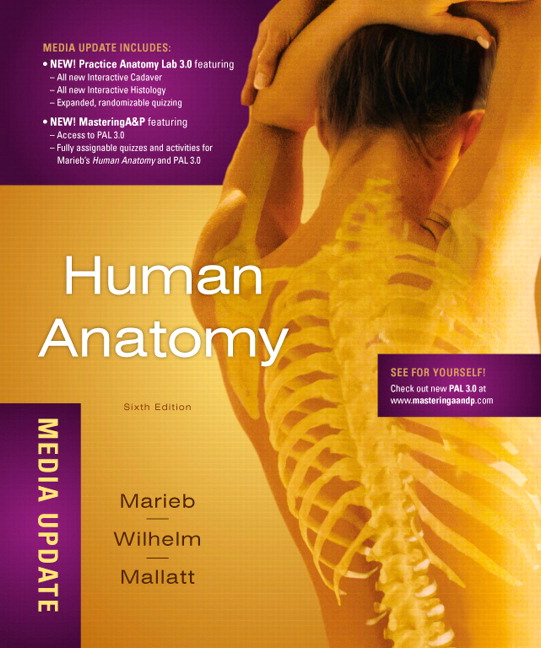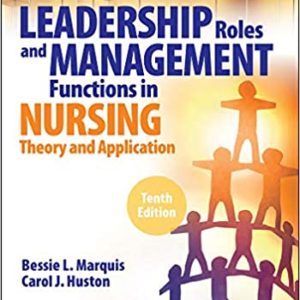Test Bank for Human Anatomy 6th Edition
$35
Description
Test Bank for Human Anatomy 6th Edition
Test Bank for Human Anatomy 6th Edition Marieb, Wilhelm, Mallatt by Rennee A. Moore
Content
1 The Human Body: An Orientation 1
2 Cells: The Living Units 18
3 Basic Embryology 34
4 Tissues 49
5 The Integumentary System 65
6 Bones and Skeletal Tissues 81
7 Bones, Part 1: The Axial Skeleton 97
8 Bones, Part 2: The Appendicular Skeleton 113
9 Joints 129
10 Skeletal Muscle Tissue 145
11 Muscles of the Body 161
12 Fundamentals of the Nervous System and Nervous Tissue 190
13 The Central Nervous System 206
14 The Peripheral Nervous System 223
15 The Autonomic Nervous System and Visceral Sensory Neurons 239
16 The Special Senses 256
17 The Endocrine System 274
18 Blood 291
19 The Heart 308
20 Blood Vessels 325
21 The Lymphatic and Immune Systems 344
22 The Respiratory System 362
23 The Digestive System 379
24 The Urinary System 398
25 The Reproductive System 416
Using Figure 1.1, match the following:
1) Mental
Answer: A
Diff: 2 Page Ref: 7
2) Umbilical
Answer: B
Diff: 2 Page Ref: 7
Copyright © 2011 Pearson Education, Inc. 1
2 Test Bank for Human Anatomy
3) Hallux
Answer: E
Diff: 2 Page Ref: 7
4) Inguinal
Answer: C
Diff: 2 Page Ref: 7
5) Femoral
Answer: D
Diff: 2 Page Ref: 7
Copyright © 2011 Pearson Education, Inc.
CHAPTER 1 The Human Body: An Orientation 3
Figure 1.2
Using Figure 1.2, match the following:
6) Lumbar
Answer: D
Diff: 2 Page Ref: 7
7) Acromial
Answer: B
Diff: 3 Page Ref: 7
8) Scapular
Answer: C
Diff: 2 Page Ref: 7
Copyright © 2011 Pearson Education, Inc.
4 Test Bank for Human Anatomy
9) Popliteal
Answer: E
Diff: 2 Page Ref: 7
10) Occipital
Answer: A
Diff: 3 Page Ref: 7
Match the following:
A. superior
B. lateral
C. anterior
D. proximal
E. deep
11) The chest is ________ to the abdomen.
Answer: superior
Diff: 2 Page Ref: 8
12) The sternal region is ________ to the scapular region.
Answer: anterior
Diff: 2 Page Ref: 7-8
13) The knee is ________ to the foot.
Answer: proximal
Diff: 3 Page Ref: 8
14) The brain is ________ to the skull.
Answer: deep
Diff: 2 Page Ref: 8
15) The thumb is ________ to the index finger.
Answer: lateral
Diff: 3 Page Ref: 8
16) Muscles are ________ to the skin.
Answer: deep
Diff: 1 Page Ref: 8
17) The axillary region is ________ to the sternum.
Answer: lateral
Diff: 2 Page Ref: 8
18) The lip is ________ to the chin.
Answer: superior
Diff: 2 Page Ref: 8
Copyright © 2011 Pearson Education, Inc.
CHAPTER 1 The Human Body: An Orientation 5
19) The eye is ________ to the occipital region.
Answer: anterior
Diff: 2 Page Ref: 7-8
20) The acromial region is ________ to the scapular region.
Answer: superior
Diff: 2 Page Ref: 7-8
21) The gluteal region is ________ to the popliteal region.
Answer: superior
Diff: 2 Page Ref: 7-8
22) The femoral region is ________ to the plantar region.
Answer: proximal
Diff: 2 Page Ref: 7-8
23) The heart is ________ to the sternum.
Answer: deep
Diff: 2 Page Ref: 8
24) The pubic area is ________ to the gluteal region.
Answer: anterior
Diff: 2 Page Ref: 7-8
25) The umbilical region is ________ to the lumbar region.
Answer: anterior
Diff: 2 Page Ref: 7-8
True/False Questions
1) Serous cavities include the pleural cavity.
Answer: TRUE
Diff: 1 Page Ref: 12
2) Serous cavities contain air.
Answer: FALSE
Diff: 2 Page Ref: 12
3) The peritoneal cavity is a serous cavity.
Answer: TRUE
Diff: 2 Page Ref: 12
4) EM has much greater resolution than LM.
Answer: TRUE
Diff: 2 Page Ref: 14
5) The dorsal body cavity is subdivided into a cranial cavity and a vertebral cavity.
Answer: TRUE
Diff: 2 Page Ref: 11
Copyright © 2011 Pearson Education, Inc.
6 Test Bank for Human Anatomy
6) Pathological anatomy deals with structural changes caused by disease.
Answer: TRUE
Diff: 2 Page Ref: 2
7) A CT scan produces an image of a transverse section of the body.
Answer: TRUE
Diff: 2 Page Ref: 16-17
8) MRI techniques can show only images that are hard and deflect the X rays.
Answer: FALSE
Diff: 2 Page Ref: 18
9) Ultrasound techniques are used to image a fetus because they are less damaging than other
techniques.
Answer: TRUE
Diff: 2 Page Ref: 18
10) Angiography imaging is used primarily in the study of blood supply to the heart wall and
brain.
Answer: TRUE
Diff: 2 Page Ref: 16
11) Most adults are between 1.5 and 2 meters tall.
Answer: TRUE
Diff: 3 Page Ref: 6
12) All vertebrate embryos have a dorsal hollow nerve cord.
Answer: TRUE
Diff: 2 Page Ref: 10
13) A transverse plane could cut the head off the body!
Answer: TRUE
Diff: 2 Page Ref: 9
14) In anatomical position, the palms of the hands face medially toward the thighs.
Answer: FALSE
Diff: 1 Page Ref: 6-7
15) The mediastinum contains the trachea and lungs.
Answer: FALSE
Diff: 2 Page Ref: 11
Copyright © 2011 Pearson Education, Inc.
CHAPTER 1 The Human Body: An Orientation 7
Multiple Choice Questions
1) The smallest living unit is
A) a cell.
B) an organ.
C) a human being.
D) a molecule.
Answer: A
Diff: 1 Page Ref: 3
2) Which branch of anatomy studies the structural changes that occur as one ages?
A) developmental anatomy
B) pathological anatomy
C) regional anatomy
D) surface anatomy
Answer: A
Diff: 2 Page Ref: 2
3) Which organ system includes the pancreas, thymus, testes, and pituitary gland?
A) integumentary
B) endocrine
C) reproductive
D) lymphatic
Answer: B
Diff: 2 Page Ref: 4-5
4) A coronal section through the human body can
A) pass through both the nose and the occipital region.
B) pass through both ears.
C) provide mirror right and left images.
D) lie in a horizontal plane.
Answer: B
Diff: 2 Page Ref: 6
5) During the process of ________, noncellular artifacts can be introduced into histology samples.
A) time
B) observation
C) staining
D) photography
Answer: C
Diff: 2 Page Ref: 14
6) The cervical region is the
A) thigh.
B) calf.
C) neck.
D) head.
Answer: C
Diff: 1 Page Ref: 7
Copyright © 2011 Pearson Education, Inc.
8 Test Bank for Human Anatomy
7) The ʺCTʺ in ʺCT scanningʺ stands for
A) cut transversely.
B) Charles Thorgaard, the inventorʹs name.
C) correlated thickness.
D) computed tomography.
Answer: D
Diff: 1 Page Ref: 16
8) What is the function of serous membranes?
A) They act like wrapping paper to hold visceral organs together.
B) They contain gland cells that secrete mucus.
C) They halt the spread of infection.
D) They reduce friction so that viscera move freely.
Answer: D
Diff: 2 Page Ref: 12
9) The dorsal hollow nerve cord
A) develops into the brain and spinal cord.
B) a primitive supporting rod.
C) contains the notochord.
D) is the same as the human backbone.
Answer: A
Diff: 2 Page Ref: 10
10) The main purpose of fixation is
A) to preserve the tissue.
B) to mend breaks in tissue sections.
C) to make an organ easier to section.
D) to stick tissue sections to a glass slide.
Answer: A
Diff: 2 Page Ref: 14
11) A histologist examines a specimen that has an epithelium overlying some smooth muscle. This
specimen is part of
A) a molecule.
B) a cell.
C) a tissue.
D) an organ.
Answer: D
Diff: 2 Page Ref: 4
12) An example of a tissue in the body is
A) the stomach.
B) a muscle cell.
C) epithelium.
D) a macromolecule.
Answer: C
Diff: 2 Page Ref: 4
Copyright © 2011 Pearson Education, Inc.
CHAPTER 1 The Human Body: An Orientation 9
13) An example of an organ is
A) a fat cell.
B) the intestine.
C) epithelium.
D) the cardiovascular system (but not the circulatory system).
Answer: B
Diff: 1 Page Ref: 4
14) Which organ system consists of vessels that do not carry blood, but pick up fluids (and some
cells) that are leaked from the blood?
A) urinary
B) endocrine
C) integumentary
D) lymphatic
Answer: D
Diff: 3 Page Ref: 4-5
15) Large molecules such as proteins are called
A) cells.
B) macromolecules.
C) multi-atom units.
D) cellular organelles.
Answer: B
Diff: 1 Page Ref: 3-4
16) Which organ system covers the external surface of the body, but not the internal surface of the
mouth?
A) lymphatic
B) digestive
C) integumentary
D) cutaneous
Answer: C
Diff: 2 Page Ref: 4-5
17) Which organ system includes the spinal cord?
A) skeletal
B) muscular
C) nervous
D) integumentary
Answer: C
Diff: 1 Page Ref: 4-5
18) The height of an average personʹs trunk, from neck to perineum, is about
A) 5 meters.
B) 10 centimeters.
C) 1000 μm.
D) 1 meter.
Answer: D
Diff: 3 Page Ref: 6
Copyright © 2011 Pearson Education, Inc.
10 Test Bank for Human Anatomy
19) Which statement concerning the anatomical position is false?
A) The palms face anteriorly.
B) The toes point anteriorly, but the fingers point inferiorly.
C) The knees, elbow, and neck are straight (not bent).
D) The person is lying down, as straight as possible.
Answer: D
Diff: 2 Page Ref: 6
20) Bilateral symmetry can apply to objects as well as to animal bodies. Which of the following
capital letters of the alphabet is not bilaterally symmetrical?
A) A
B) M
C) L
D) O
Answer: C
Diff: 2 Page Ref: 10
21) Which structure is not covered by visceral serosa?
A) lungs
B) ribs
C) stomach
D) uterus
Answer: B
Diff: 2 Page Ref: 12
22) The femoral region is the
A) buttocks.
B) hip.
C) thigh.
D) toes.
Answer: C
Diff: 1 Page Ref: 7
23) The inguinal region lies
A) anterior to the elbow joint.
B) on the anterior neck.
C) where the thigh joins the trunk.
D) on the external genitals.
Answer: C
Diff: 2 Page Ref: 7
24) The perineal region is the
A) side of the leg.
B) region between the external genitals and the anus.
C) point of the shoulder.
D) superior part of the gluteal region.
Answer: B
Diff: 2 Page Ref: 7
Copyright © 2011 Pearson Education, Inc.
CHAPTER 1 The Human Body: An Orientation 11
25) Which structure is not present in the mediastinum?
A) esophagus
B) heart
C) lung
D) trachea
Answer: C
Diff: 2 Page Ref: 11
26) A frontal plane is the same as a ________ plane.
A) midsagittal
B) transverse
C) coronal
D) sagittal
Answer: C
Diff: 2 Page Ref: 9
27) Another name for the midsagittal plane is
A) parasagittal.
B) oblique.
C) coronal.
D) median.
Answer: D
Diff: 2 Page Ref: 9
28) What point or structure in the body is located farthest laterally? (Hint: Questions always refer
to the anatomical position.)
A) the coxal region
B) ear
C) little toe
D) tip of thumb
Answer: D
Diff: 3 Page Ref: 7-8
29) Although transmission electron microscopy is usually used for high-magnification viewing, it
is certainly possible to use it at low magnification as well. That is, one can produce similar
micrographs of tissues taken by light microscopy and electron microscopy at the same
magnification. Even at the same magnification, however, you can easily tell the two kinds of
micrographs apart. How?
A) The image in the electron micrograph is still sharper.
B) Tissue viewed by electron microscopy is colored, whereas light micrographs are always
black and white (and shades of gray).
C) Tissue for light microscopy cannot be fixed (no fixation).
D) Tissue for electron microscopy cannot be sectioned.
Answer: A
Diff: 2 Page Ref: 14
Copyright © 2011 Pearson Education, Inc.
12 Test Bank for Human Anatomy
30) What is the main advantage of MRI as a medical imaging technique?
A) It is safe.
B) The patient feels less pain during the procedure than with any other imaging technique.
C) It is very inexpensive.
D) It shows soft tissues very clearly.
Answer: D
Diff: 2 Page Ref: 18
31) The extremities are the same as
A) the ears.
B) the fingers and toes.
C) the limbs.
D) all structures in the head.
Answer: C
Diff: 2 Page Ref: 6
32) Which of the following pairs of organs/structures is located ipsilateral?
A) cecum : sigmoid colon
B) descending colon : spleen
C) mouth : navel
D) right lung : left lung
Answer: B
Diff: 3 Page Ref: 8
33) A physician viewing an injury to the back would look at the patientʹs ________ side.
A) lateral
B) posterior
C) cranial
D) ventral
Answer: B
Diff: 2 Page Ref: 7
34) The ________ body cavity contains the brain.
A) dorsal
B) ventral
C) serous
D) lateral
Answer: A
Diff: 2 Page Ref: 11
35) The roots of anatomical terminology lie mainly in
A) German and French.
B) Latin and Greek.
C) Esperanto.
D) Russian and Old English.
Answer: B
Diff: 2 Page Ref: 2
Copyright © 2011 Pearson Education, Inc.
CHAPTER 1 The Human Body: An Orientation 13
36) The _____________ cavity contains the heart and lungs.
A) abdominopelvic
B) dorsal
C) thoracic
D) lateral
Answer: C
Diff: 2 Page Ref: 11
37) Hormones are regulatory proteins that are secreted by the ________ system.
A) urinary
B) endocrine
C) integumentary
D) lymphatic
Answer: B
Diff: 2 Page Ref: 4-5
38) Which organ system keeps blood constantly supplied with oxygen, removes carbon dioxide,
and contains many air tubes?
A) urinary
B) endocrine
C) integumentary
D) respiratory
Answer: D
Diff: 2 Page Ref: 4-5
39) The elimination of nitrogenous wastes from body fluids is regulated by the ________ system.
A) urinary
B) endocrine
C) integumentary
D) lymphatic
Answer: A
Diff: 1 Page Ref: 4-5
40) Which structures are evidence of the vertebrate characteristic of segmentation?
A) branches of the blood vessels
B) multiple joints of fingers
C) subdivisions of the gastrointestinal tract
D) vertebral column
Answer: D
Diff: 2 Page Ref: 10-11
41) Which statement about visceral serosa is false?
A) It clings to the surface of organs.
B) It is continuous with the membrane that covers the outer body wall.
C) It is deep to the parietal serosa.
D) It lines the internal surface of hollow organs.
Answer: D
Diff: 2 Page Ref: 12
Copyright © 2011 Pearson Education, Inc.
14 Test Bank for Human Anatomy
42) How many centimeters are there in a meter?
A) 10
B) 100
C) 1,000
D) 1,000,000
Answer: B
Diff: 3 Page Ref: 6
43) Which organ is not found in the ventral body cavity?
A) heart
B) liver
C) spinal cord
D) urinary bladder
Answer: C
Diff: 2 Page Ref: 11
44) The ankle lies ________ to the thigh.
A) distal
B) proximal
C) lateral
D) deep
Answer: A
Diff: 2 Page Ref: 9
45) The axillary artery is found in the region of the
A) posterior surface of the knee.
B) vertebral column.
C) armpit.
D) long axis of any limb.
Answer: C
Diff: 2 Page Ref: 7
46) As an anatomical region, lumbar refers to
A) the loin of the back.
B) part of the lower limb.
C) the wrist.
D) the breast.
Answer: A
Diff: 2 Page Ref: 7
47) The buccal region is the
A) cheeks.
B) waist.
C) calf of the leg.
D) underside of the foot.
Answer: A
Diff: 2 Page Ref: 7
Copyright © 2011 Pearson Education, Inc.
CHAPTER 1 The Human Body: An Orientation 15
48) The popliteal region is
A) the side of the leg.
B) in the cervical region.
C) the posterior surface of the knee.
D) the inferior part of the gluteal region.
Answer: C
Diff: 2 Page Ref: 7
49) The coxal region is
A) the same as the inguinal region.
B) the skin over the ʺtailbone.ʺ
C) the hip.
D) the posterior surface of the wrist.
Answer: C
Diff: 2 Page Ref: 7
50) Which abdominal structure is located in the right hypochondriac region?
A) appendix
B) gallbladder
C) spleen
D) stomach
Answer: B
Diff: 2 Page Ref: 13
Short Answer Questions
1) Describe the difference between proximal and distal.
Answer: Proximal means closer to the point of attachment to the main part of the body; distal is
further.
Diff: 2 Page Ref: 8
2) Describe the location of the thigh to the calf.
Answer: The thigh is proximal to the calf.
Diff: 2 Page Ref: 7-8
3) Describe the location of the upper arm to the fingertips.
Answer: The upper arm is proximal to the fingertips.
Diff: 2 Page Ref: 7-8
4) In humans, what term is synonymous with posterior?
Answer: dorsal
Diff: 2 Page Ref: 8
5) Clinicians refer to ________ anatomy when locating blood vessels to draw
You must be logged in to post a review.




Reviews
There are no reviews yet.